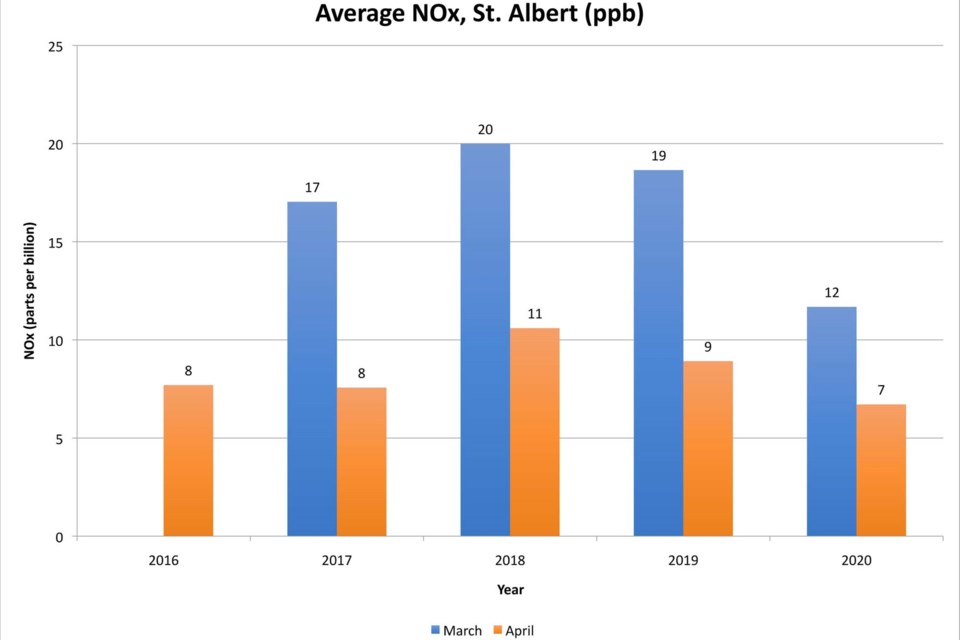One type of air pollution has dropped to historic lows in St. Albert in recent months, a new analysis suggests, likely due in part to the coronavirus.
The Gazette worked with Alberta Capital Airshed data manager Kevin McCullum to see if there had been any changes in air pollution in the St. Albert region since COVID-19 restrictions began in Alberta.
The coronavirus pandemic has caused governments to shut down swaths of industries and businesses, and required millions of people to stay home and not drive. St. Albert is no exception, with traffic on major roads in St. Albert down about 45 per cent in recent weeks compared to mid-February, City of St. Albert spokesperson Florence Ma said in an email.
That means St. Albert should see less car-related air pollution, particularly nitrogen oxides (NOx), McCullum said.
Nitrogen oxides such as nitrogen dioxide (NO2) are pollutants commonly released by burning fossil fuels by cars and power plants, the U.S. Environmental Protection Agency (EPA) reports. They create atmospheric haze and acid rain, and can contribute to asthma and other respiratory diseases.
McCullum examined average NOx levels at four St. Albert and Edmonton monitoring stations during March and April (which is when pandemic public health orders were active) and compared them to those same months in previous years.
He found that NOx levels at the St. Albert air monitoring station near Vital Grandin School averaged 12 parts per billion in March – about 37 per cent below what they were March 2019 (19 ppb) and the lowest they’ve been (by all of 5 ppb) for March since the station started operations in 2016.
Likewise, NOx levels at the Edmonton Central station averaged 20 ppb in March – a record low for that month and about 33 per cent below March 2019 levels. Edmonton East showed a 38-per-cent drop for this past March relative to March 2019 (16 ppb from 26), while Edmonton South dropped by about 48 per cent (11 from 21).
McCullum did not find significant pollution changes in April. St. Albert set a record low for NOx in April with an average of 7 ppb, but that was just 2 ppb below last April and 1 ppb below the old record. (One part per billion is one drop in 520 bathtubs.)
Edmonton Central set a new April record of 14 ppb, or one point below last year. Edmonton East and South saw similar drops but did not set new records.
“We’re talking pretty much status quo from previous years,” McCullum said.
Not much change
Researchers have seen NO2 levels over parts of China drop 10 to 30 per cent in recent months, with parts of Italy seeing similar declines. In both cases, these drops have been attributed in part to less economic activity due to the pandemic.
Some of the drop we’ve seen here is seasonal, McCullum explained. We use less heat and idle cars less when it is warm, so we see dips in fossil fuel use and NOx come spring. The drop also reflects decades-long trends in NOx reductions due to rising car emission standards.
Temperature and ozone levels can also affect NOx, said St. Albert environmental consultant and air quality specialist David Spink. April was colder than usual, and that may have led to more pollutant-trapping atmospheric inversions, masking any drops we could have seen that month.
While the health effects of a drop this small might be hard to quantify, Spink said they are still significant. Epidemiological studies have found there are no safe levels when it comes to NO2, and that NO2 levels in Canada are high enough to cause health impacts.
“What it demonstrates is how significant we and our automobiles are in terms of our influence on air quality,” he said.
“There are advantages to staying out of your car by working from home if you can, in terms of improving air quality.”
McCullum’s analysis can be found at bit.ly/2WLZnh9.




